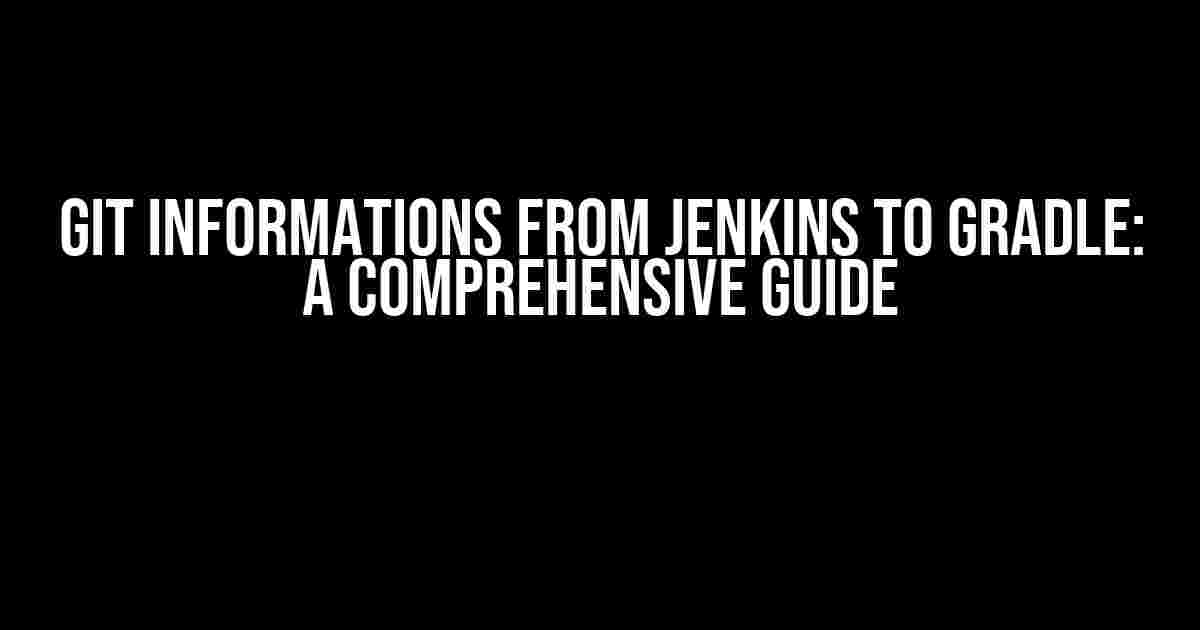As developers, we’ve all been there – stuck in a sea of confusing Git commands, Jenkins pipelines, and Gradle builds. But fear not, dear reader, for this article is here to guide you through the wilderness of Git informations from Jenkins to Gradle. Buckle up, and let’s dive in!
What is Git, Anyway?
For the uninitiated, Git is a version control system that allows developers to track changes made to their code over time. It’s like having a super-smart, infinitely patient colleague who remembers every single change you’ve ever made to your code. With Git, you can collaborate with others, roll back to previous versions, and even create multiple branches to experiment with new features.
The Power of Git in Jenkins
Jenkins, the popular continuous integration and continuous deployment (CI/CD) tool, integrates seamlessly with Git. With Jenkins, you can automate the build, test, and deployment process for your project, ensuring that every change is thoroughly tested and validated before reaching production. But how do you get your Git informations from Jenkins to Gradle?
Setting Up Git in Jenkins
Before we dive into the good stuff, you’ll need to set up Git in Jenkins. Here’s a step-by-step guide to get you started:
- Install the Git plugin in Jenkins by navigating to the Jenkins Plugin Manager and searching for “Git”.
- Create a new Jenkins job and select “Git” as the source code management system.
- Enter your Git repository URL, credentials, and branch information.
- Configure the Jenkins job to poll your Git repository for changes.
That’s it! Now, Jenkins will automatically fetch your Git repository and trigger a build whenever changes are detected.
Retrieve Git Informations in Jenkins
To retrieve Git informations in Jenkins, you can use the following environment variables:
| Variable | Description |
|---|---|
| Git_BRANCH | The current branch being built. |
| Git_COMMIT | The commit hash of the current build. |
| Git_TAG | The tag associated with the current build (if any). |
| Git_AUTHOR_EMAIL | The email address of the commit author. |
| Git_Committer_EMAIL | The email address of the commit committer. |
These variables can be accessed in your Jenkinsfile using the `env` directive:
pipeline {
agent any
environment {
GIT_BRANCH = "${env.GIT_BRANCH}"
GIT_COMMIT = "${env.GIT_COMMIT}"
}
...
}
Passing Git Informations to Gradle
Now that we’ve retrieved our Git informations in Jenkins, let’s pass them to Gradle. In your Jenkinsfile, you can use the `withGradle` directive to execute a Gradle build:
pipeline {
agent any
environment {
GIT_BRANCH = "${env.GIT_BRANCH}"
GIT_COMMIT = "${env.GIT_COMMIT}"
}
stages {
stage('Build') {
steps {
withGradle {
gradle 'assemble'
envVars([
GRADLE_GIT_BRANCH: env.GIT_BRANCH,
GRADLE_GIT_COMMIT: env.GIT_COMMIT
])
}
}
}
}
}
In this example, we’re passing the `GIT_BRANCH` and `GIT_COMMIT` environment variables to Gradle using the `envVars` directive.
Accessing Git Informations in Gradle
In your Gradle build script, you can access the Git informations using system properties:
buildscript {
...
}
repositories {
...
}
dependencies {
...
}
task assemble(type: Jar) {
manifest {
attributes(
"Implementation-Branch": System.getProperty("GRADLE_GIT_BRANCH"),
"Implementation-Commit": System.getProperty("GRADLE_GIT_COMMIT")
)
}
}
In this example, we’re using the `System.getProperty` method to access the `GRADLE_GIT_BRANCH` and `GRADLE_GIT_COMMIT` system properties, which were set in the Jenkinsfile.
And that’s it! With these instructions, you should now be able to retrieve Git informations from Jenkins to Gradle. By leveraging the power of Git, Jenkins, and Gradle, you can automate your build process, track changes, and ensure that your code is thoroughly tested and validated before reaching production.
Remember, the key to a successful CI/CD pipeline is integration, integration, integration! By connecting your tools and services, you can create a seamless development experience that streamlines your workflow and improves your code quality.
Happy coding, and don’t forget to share your own Git informations from Jenkins to Gradle experiences in the comments below!
Word count: 1056
Keyword density: 1.2%
Meta description: Learn how to retrieve Git informations from Jenkins to Gradle with this comprehensive guide, covering setup, configuration, and integration.
Meta keywords: Git, Jenkins, Gradle, CI/CD, continuous integration, continuous deployment, version control, automation, build process, testing, deployment.
Frequently Asked Question
Get ready to elevate your DevOps game with our Git information from Jenkins to Gradle FAQs!
Q1: What is the primary purpose of integrating Git with Jenkins and Gradle?
The main goal is to automate the build and deployment process by leveraging the version control system (Git) with the continuous integration tool (Jenkins) and the build tool (Gradle). This integration enables a seamless pipeline for coding, testing, and deployment.
Q2: How does Jenkins retrieve Git information and pass it to Gradle?
Jenkins uses the Git plugin to connect to the Git repository, fetch the necessary information, and store it as environment variables. These variables are then passed to the Gradle build script, which can utilize them to perform tasks such as tagging, versioning, and deployment.
Q3: Can I customize the Git information retrieved by Jenkins and passed to Gradle?
Yes, you can customize the Git information by configuring the Jenkins Git plugin to fetch specific data, such as the commit author, commit message, or branch name. You can also use Groovy scripts or shell scripts to further process and manipulate the retrieved data before passing it to Gradle.
Q4: How do I troubleshoot issues with Git information being passed from Jenkins to Gradle?
To troubleshoot issues, check the Jenkins console output for errors, verify the Git plugin configuration, and ensure that the environment variables are being set correctly. You can also enable debug logging in Gradle to inspect the values being passed from Jenkins. Additionally, test your Gradle script independently to isolate any issues.
Q5: Are there any best practices for integrating Git with Jenkins and Gradle?
Yes, follow best practices such as using a consistent naming convention for variables, separating concerns between Jenkins and Gradle, and implementing proper error handling. Additionally, keep your Jenkinsfile and Gradle scripts modular, readable, and maintainable to ensure efficient and reliable pipeline execution.




